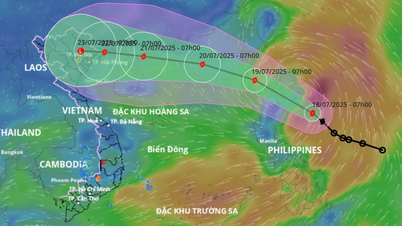Aurora on Jupiter recorded by James Webb Space Telescope - Video : Space
In the deep dark of space, where the light of the Sun is just a dim spot, Jupiter - the largest planet in the solar system - is performing a magnificent dance of light never seen before.
The latest images from the James Webb Space Telescope have stunned astronomers by showing that Jupiter's aurora is not only similar to Earth's aurora, but also hundreds of times more powerful and brilliant.
According to information released by the US National Aeronautics and Space Administration (NASA) on May 12, an international research team led by scientist Jonathan Nichols of the University of Leicester (UK) analyzed data collected from James Webb.
The results showed that the light bands on Jupiter are not only intense, but also change rapidly and energetically - a feature that even great probes like Voyager 2 could only "dream" of recording before.
Like Earth, Jupiter's auroras are created when high-energy charged particles from space collide with gas atoms in the atmosphere near the planet's magnetic poles. The difference, however, lies in their origin and intensity.
While Earth needs solar storms to “trigger” its auroras, Jupiter has another unique source of energy: its moon Io, the most volcanically active satellite in the solar system. Violent eruptions from Io release large amounts of charged particles into space, adding “fuel” to Jupiter’s auroras.
Although the formation mechanism is somewhat similar to the Northern or Southern aurora on Earth, in terms of scale and brilliance, Jupiter's aurora is a completely different world : overwhelming, intense and surreal.
The image taken by James Webb - the most sophisticated instrument ever launched into space by humans - on Christmas Eve 2023 has brought us closer to that unimaginable beauty. Under the infrared view of the telescope, the moving bands of light are like the heartbeat of a giant planet, carrying the energy of the universe and the history of billions of years of formation.
This is strong evidence that Jupiter's magnetic field - the strongest in the solar system - is creating spectacular reactions with the solar wind and could provide clues about atmospheric conditions on exoplanets, scientists say.
Previously, James Webb also caused a stir when he recorded faint but magical images of auroras on Neptune - a distant and icy planet that was only faintly detected by the Voyager 2 probe during its only flyby decades ago.
Now, with valuable data on Jupiter, the telescope continues to affirm its pioneering role in opening the door to understanding the universe.
Source: https://tuoitre.vn/khoa-hoc-sung-sot-truoc-cuc-quang-du-doi-tren-sao-moc-20250513192739625.htm




























































































![[Infographic] In 2025, 47 products will achieve national OCOP](https://vphoto.vietnam.vn/thumb/402x226/vietnam/resource/IMAGE/2025/7/16/5d672398b0744db3ab920e05db8e5b7d)





Comment (0)